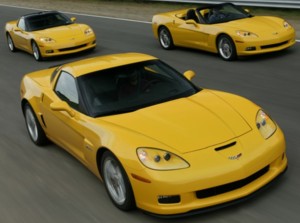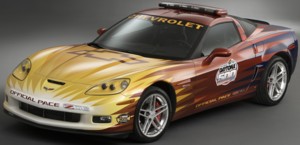|
By winning every race in the 2004 season, the Corvette C5-R racing team wrapped up the most successful era in Corvette’s
50-year racing history. In its five years, the C5-R racing program took 35 victories in 55 races, four American Le Mans Series
championships and three double victories at the 24 Hours of LeMans.
The Z06 sparked the second half of the C5’s
life span with a Corvette model for the extreme performance enthusiast. Now, Team Corvette combines the numerous attributes
of the sixth-generation Corvette with the technology and winning determination from the C5-R program to take the new Z06 to
the next level in total performance.
The links between racing and the production Z06 are both direct and indirect,
as the vehicle was developed in conjunction with the C6-R racecar, but they boil down to the application of lessons that could
only have been learned after countless laps of endurance racing.

-Aluminum body structure with one-piece hydroformed perimeter rails frame and magnesium front cradle
-Fixed roof design
optimizes body rigidity and aerodynamics
-Carbon-fiber composite front fenders and front wheelhouses
-Unique front
fascia incorporating a larger grille, cold-air scoop and lower air splitter
-Wide-body rear fenders and a unique rear
spoiler incorporated with the CHMSL
-Huge 14-inch (355-mm) cross-drilled front disc brakes with six-piston calipers and
-13.4-inch (340-mm) cross-drilled rear rotors with four-piston calipers
-18 x 9.5-inch front wheels with 275/35ZR18 tires
and 19 x 12-inch rear wheels with 325/30ZR19 tires
-3-inch-diameter exhaust with bi-mode mufflers and larger polished
stainless steel tips
-Engine, transmission and differential oil coolers; and steering cooler
-Rear-mounted battery
to improve weight distribution
-Unique interior features including revised gauge cluster and lightweight two-tone seats
with more aggressive bolsters
Curb weight of 3130 pounds / 1419.7 kg (estimated)
3 inches (76.2 mm) wider than other
Corvette models
Vehicle developed simultaneously with C6-R racecar. The features above are merely the highline points
of the comprehensively designed Z06. What follows is a closer look at the vehicle’s unique attributes.
LS7 engine
The all-new LS7 of the ’06 Z06 reintroduces the 427-cubic-inch engine to the Corvette lineup. Unlike the previous
427 engine, which was a big-block design, the new 7.0-liter LS7 is a small-block V-8 – the largest-displacement small-block
ever produced by GM and a tribute to its 50 years as a performance icon.
With 500 horsepower and 475 lb.-ft. of torque,
it also is the most powerful passenger car engine ever produced by Chevrolet and GM. The LS7 is easily identified under the
hood by red engine covers with black lettering.
The LS7 shares the same basic Gen IV V-8 architecture as the Corvette’s
6.0-liter LS2, but the LS7 uses a different cylinder block casting with pressed-in steel cylinder liners to accommodate the
engine’s wide, 104.8-mm-wide cylinder bores; the LS2 has 101.6-mm bores. And when compared to the LS2, the LS7 also
has a different front cover, oil pan, exhaust manifolds and cylinder heads.
Internally, the LS7’s reciprocating
components make use of racing-derived lightweight technology, including titanium connecting rods and intake valves, to help
boost horsepower and rpm capability. The rpm fuel shut-off limit is 7000 rpm.
The LS7’s specifications include:
-505 horsepower (373 kw) @ 6200 rpm
-470 lb.-ft. of torque (657 Nm) @ 4800 rpm
-7000 rpm redline
-Unique cylinder block casting with large, 104.8-mm bores and pressed-in cylinder liners
-Forged steel main
bearing caps
-Forged steel crankshaft
-Titanium connecting rods with 101.6-mm stroke, cast aluminum
flat-top pistons
-11.0:1 compression
-Dry-sump oiling system
-Camshaft with .591-inch lift
-Racing-derived
CNC-ported aluminum cylinder heads with titanium intake valves and sodium-filled exhaust valves
-Titanium pushrods and
valve springs
-Low-restriction air intake system
-Hydroformed exhaust headers with unique “quad flow”
collector flanges.
All LS7 engines are assembled by hand at GM Powertrain’s new Performance Build Center
in Wixom , Mich. The exacting standards to which they are built include deck-plate honing of the cylinders – a procedure
normally associated with the building of racing engines and almost unheard of in a production-vehicle engine.
Drivetrain
....
The Corvette Z06’s powertrain and drivetrain systems are matched to the LS7’s performance capability.
The light, four-into-one headers discharge in to new, close-coupled catalytic converters and through to new “bi-modal”
mufflers. The mufflers each feature a vacuum-actuated outlet valve, which controls exhaust noise during low-load operation
but opens for maximum power.
At the rear of the LS7 engine, a single-mass flywheel and lightweight, high-capacity
clutch channel torque to the rear transaxle. The six-speed manual transmission has been strengthened to handle the LS7’s
increased torque load. The transmission includes a pump which sends transmission fluid to the front radiator for cooling.
Upon its return, the fluid removes additional heat from the differential lube before returning to the transmission.
The
M6 transmission connects to a limited-slip differential, with enlarged ring and pinion gears. Stronger axle half-shafts with
tougher universal joints transmit power to the rear wheels.
Body structure...
The Z06 has a unique aluminum
body structure for optimum stiffness and light weight for the fixed-roof bodystyle. Perimeter rails are one-piece hydroformed
members featuring cast suspension nodes, which replace many welded steel components on other Corvette models. Other castings,
stampings and extrusions are combined into the innovative structure with state-of-the-art manufacturing technologies.
Advanced
structural composites featuring carbon fiber are bonded to the aluminum structure. The wider front wheelhouses, for example,
are carbon composites and the passenger compartment floors combine carbon-fiber skins with an ultra-lightweight balsa wood
core.
Chassis system ...
The 2006 Corvette Z06 has a new magnesium cradle that serves as the attachment
point for the engine and some front suspension components. Magnesium is lighter than aluminum yet incredibly strong. The magnesium
cradle helps improve the front-to-rear weight distribution, as do carbon-fiber front fenders and wheelhouses. Engineers also
moved the battery from underhood to a position in the rear cargo area, behind one of the rear wheels. “This is an instance
where the street car uses more advanced material than the racecar,” said Hill. “We’re constrained by rules
to run the steel frame in the racecars, but we stretched to bring even more performance technology to the street for out customers.”
The mass reductions are offset by some added performance enablers, including dry-sump lubrication, 3-inch (76.2-mm) exhaust
with outlet valves, larger wheels and tires, more power brake and stiffer roll stabilizers.
Suspension, brakes, wheels
and tires The Z06 retains the 106-inch (2686-mm) wheelbase of other Corvette models, as well as the short-long arm suspension
and transverse leaf spring design, but it rides on all-new wheels, tires, brakes, as well as its own rear spring and roll
stabilizer.
The firmer suspension works harmoniously with large 18 x 9.5-inch cast-spun aluminum wheels and 275/35ZR18
tires in the front, and 19 x 12-inch cast-spun aluminum wheels with 325/30ZR19 tires in the rear – the largest wheel-and-tire
combination ever offered on a Corvette. The tires use the latest extended-mobility technology from Goodyear to provide a satisfactory
ride, but still allow the vehicle to achieve lateral acceleration of more than 1 g. The extended-mobility tires eliminate
the need – and weight – for a spare tire and jack or inflator kit, and reduce the chance of a sudden loss of handling
capability.
Complementing the suspension system and large rolling stock is an equally capable four-wheel disc brake
system, consisting of 14-inch (355-mm) vented and cross-drilled front rotors and 13.4-inch (340-mm) vented and cross-drilled
rear rotors. For comparison, the ’05 Corvette has 12.8-inch (325-mm) front and 12-inch (305-mm) rear rotors, while the
’05 Corvette with the Z51 has 13.4-inch (340-mm) and 13-inch (330-mm) rotors.
The front rotors are acted upon
by huge, red-painted six-piston calipers that use six individual brake pads. Individual brake pads are used because they deliver
more equalized wear compared to what would otherwise be a pair of very long single-piece pads. For the rear brakes, four-piston
calipers with four individual brake pads are used. A Delphi four-channel ABS system is used, as is a very competent active
handling system – complete with a Competitive Driving mode.
The large brakes bring an excellent level of stopping
capability with the Z06, and with their four-wheel brake cooling, they provide excellent fade resistance and lining life during
track duties.
Distinct design...
The new Z06 has an unmistakable and aggressive appearance, with design cues
that include:
A wide front fascia with a large, forward-facing grille opening, a splitter along the bottom and “Gurney
lips” along the sides to provide aerodynamic downforce
A cold air scoop in front of the hood that integrates an
air inlet system for the engine
The trailing edge of the front wheel opening is radiused to achieve improved drag, but
protects the body finish with a tough molding, and a large air extractor is located behind the wheel
A fixed-roof bodystyle
optimizes body rigidity and aerodynamics
Wider rear fenders with flares cover the massive rear tires and a brake cooling
scoop in front of the wheels visually balances the fender extractor
A tall rear spoiler houses the CHMSL on the top of
the rear fascia
10-spoke wheels
Four larger stainless steel exhaust outlets
New-design Z06 badging on the front
fenders While the function of the Z06’s design is to move air efficiently over the body and reduce lift, the net effect
is a car that looks like a weight lifter whose muscles are straining the seams of his shirt.
The aerodynamics of the
Z06’s exterior were shaped by the experiences of the Corvette racing program, where high-speed stability and cornering
capability are paramount. And while the racecars use large rear wings, the Z06’s elevated spoiler provides sufficient
downforce to balance the road-worthy front splitter without adversely affecting aerodynamic drag. The Z06’s Cd is .31.
-------------------
Of course the Coupe and Convertible versions are still avalible, but only avalible with the 400hp
6.0L LS2

2006 Corvette Options List
Corvette Racing (C6-R) Website
C6-R Pictures & Info
Z06 Pictures & Info
VIDEO: 2006 Z06 vs Viper vs Ford GT
| 2006 Daytona 500 Pace Car |

|
| 2006 Corvette Z06 |
A specially-prepared Corvette Z06 will serve as the Official Pace Car of the 48th annual Daytona 500, on Feb. 19, 2006. Because
of the unique restrictor plate rule at Daytona, which limits airflow into the cars engines to keep track speeds below 200
mph, the Corvette Z06 actually makes more horsepower (505hp) than the cars competing in the Daytona 500 - a first for a pace
car.
Also the new Z06 was the 8th Corvette to Pace the Indianapolis 500.
2006 Indy 500 Pace Car
|

